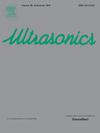Confidence-enhanced flow trajectory imaging using speckle tracking with multi-angle plane waves
IF 4.1
2区 物理与天体物理
Q1 ACOUSTICS
引用次数: 0
Abstract
Flow trajectory imaging, which tracks flow particles over time to map path-dependent trajectories, is a valuable tool for analyzing flow dynamics in pathological vascular conditions. Accurate trajectory estimation depends on robust vector flow imaging (VFI) methods to minimize cumulative errors. However, Doppler-based VFI methods are limited by aliasing and ensemble-sensitive estimation errors, while speckle tracking (ST) methods suffer from poor lateral velocity estimation due to beam diffraction. Additionally, existing trajectory imaging techniques lack a confidence metric to address unreliable estimates, leading to error propagation. To overcome these limitations, we propose a novel ST-based VFI technique leveraging multi-angle ultrafast plane wave imaging. Projected axial velocity components are estimated from baseband beamformed data for each steered plane wave and combined using a normalized cross-correlation (NCC)-weighted least-squares approach to generate velocity vectors. To ensure robust trajectory estimation, peak NCC values are incorporated to discard unreliable estimates and enhance confidence in the results. Simulation and experimental results demonstrate that the proposed method outperforms conventional ST and autocorrelation-based VFI by at least threefold and twofold in bias and standard deviation, respectively. It also shows better performance at low signal-to-noise ratios. In vivo measurements of the right carotid artery over one cardiac cycle highlight the ability of our method to visualize dynamic flow patterns and provide more accurate flow trajectory estimation compared to existing Doppler- and ST-based methods.
利用多角度平面波散斑跟踪技术增强流动轨迹成像的可信度
流动轨迹成像,跟踪流动颗粒随时间的变化,绘制路径依赖的轨迹,是分析病理血管状态下流动动力学的有价值的工具。准确的弹道估计依赖于鲁棒矢量流成像(VFI)方法来最小化累积误差。然而,基于多普勒的VFI方法受到混叠和集成敏感估计误差的限制,而散斑跟踪(ST)方法由于光束衍射而受到横向速度估计差的影响。此外,现有的轨迹成像技术缺乏一个置信度度量来解决不可靠的估计,导致误差传播。为了克服这些限制,我们提出了一种新的基于st的VFI技术,利用多角度超快平面波成像。从每个导向平面波的基带波束形成数据中估计投影轴向速度分量,并使用归一化互相关(NCC)加权最小二乘方法组合以生成速度矢量。为了确保弹道估计的鲁棒性,将峰值NCC值纳入其中以丢弃不可靠的估计并提高结果的可信度。仿真和实验结果表明,该方法在偏置和标准差上分别优于传统的ST和基于自相关的VFI至少三倍和两倍。它在低信噪比下也表现出更好的性能。在一个心动周期内对右颈动脉的体内测量突出了我们的方法可视化动态血流模式的能力,与现有的基于多普勒和st的方法相比,我们的方法提供了更准确的血流轨迹估计。
本文章由计算机程序翻译,如有差异,请以英文原文为准。
求助全文
约1分钟内获得全文
求助全文
来源期刊

Ultrasonics
医学-核医学
CiteScore
7.60
自引率
19.00%
发文量
186
审稿时长
3.9 months
期刊介绍:
Ultrasonics is the only internationally established journal which covers the entire field of ultrasound research and technology and all its many applications. Ultrasonics contains a variety of sections to keep readers fully informed and up-to-date on the whole spectrum of research and development throughout the world. Ultrasonics publishes papers of exceptional quality and of relevance to both academia and industry. Manuscripts in which ultrasonics is a central issue and not simply an incidental tool or minor issue, are welcomed.
As well as top quality original research papers and review articles by world renowned experts, Ultrasonics also regularly features short communications, a calendar of forthcoming events and special issues dedicated to topical subjects.
 求助内容:
求助内容: 应助结果提醒方式:
应助结果提醒方式:


